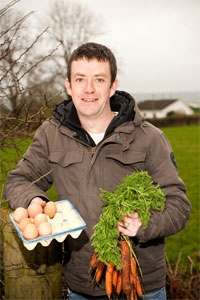Grow it Yourself - November
 Back in late summer when the broad beans, early peas and early spuds were finished cropping, I cleaned up the beds and sowed a green manure called phacelia in the beds (the seeds were broadcast liberally in the soil and then raked in). The seeds germinated within a few days, and within weeks we had a lovely carpet of light green plants covering the beds. This week, the phacelia was ready to be cut down and dug in to the soil.
Back in late summer when the broad beans, early peas and early spuds were finished cropping, I cleaned up the beds and sowed a green manure called phacelia in the beds (the seeds were broadcast liberally in the soil and then raked in). The seeds germinated within a few days, and within weeks we had a lovely carpet of light green plants covering the beds. This week, the phacelia was ready to be cut down and dug in to the soil.
A green manure is a fast growing ‘cover’ crop grown specifically to add nutrients and organic matter to the soil. While it is growing the green manure protects the soil (its roots hold the soil together) and because it grows so quickly, it also suppresses weeds.
Green manures are dug in to the soil when the plants are still young and typically before they flower (the phacelia was just starting to produce pretty little blue flowers). The green leafy material is very high in nutrients and so, as it decomposes it improves and protects the soil. The upside of digging in when the plants are young is that they are still quite tender and easy to work with. They also break down in the soil quite quickly. Left to get too old and tough, and it becomes a more difficult job.
 To dig in the manure, I simply used a shears to chop down the manure at ground level. I also chopped at the plants to break them down in to smaller bits as I went. I have heard of people using a strimmer where there are larger areas of ground covered in green manure, but the shears were fine for me and it didn’t take long.
To dig in the manure, I simply used a shears to chop down the manure at ground level. I also chopped at the plants to break them down in to smaller bits as I went. I have heard of people using a strimmer where there are larger areas of ground covered in green manure, but the shears were fine for me and it didn’t take long.
I then simply got a fork and turned the soil over, incorporating everything (including the roots) as I went. It’s important not to go too deep – the green manure will rot down best and have the most impact if dug in quite shallow (about 15cm).
You can sow a new crop in the bed after three to four weeks – as mentioned above, my beds will be covered down with polythene now so hopefully those nutrients from the green manure will be preserved over the winter months.
Things to Do this Month - November
To Do
Do not leave beds bare for the winter – sow a green manure, or cover with a thick layer of manure/compost and then black plastic or straw. This will return nutrients to the soil, keep the worst of the weather off it, suppress weeds and prevent leaching of nutrients. ‘Earth up’ or tie up vegetables such as cabbage, cauliflower and Brussels sprouts. Divide up your rhubarb if you want to propagate, and cover it with a thick mulch of manure. Prune apple trees. Mulch fruit bushes. Take cuttings of currant bushes from current season’s wood.
Sow
Sow broad beans outside now for an early crop next spring. To avoid rotting before germination, make small newspaper cups and germinate them indoors first. Next summer’s garlic does best if it’s planted before Christmas – plant outdoors in well prepared soil in a sunny spot. Though I have to admit I never bother with them, some varieties of onion can over-winter and will be ready to harvest in early summer.
Harvest
Continue to harvest perpetual spinach, cabbage, cauliflower, potatoes, swede, parsnips, apples, pears. Start harvesting leeks, winter cabbage, kale, artichokes, Brussels sprouts. Time to lift carrots and turnips or at least cover them with a good layer of straw to protect them from frost damage.
Recipe of the Week – Beetroot Relish
At my talk at the GIY Gathering this year I discussed how beetroot is in my top 5 vegetables to grow. One of the people in the audience, Máire Jones, from GIY Rush & Skerries kindly sent me this lovely recipe to make beetroot relish – another option for ‘storing’ this wonderful crop.
Ingredients:
• 3lb cooked beetroot
• 1lb onions, chopped
• 1lb cooking apples, peeled and chopped
• 1tsp salt
• 2lb granulated sugar
• 24 fl oz red wine vinegar
Directions:
Peel and cut beet into cubes, or mash if smooth relish required. Place onion into a large preserving pan with a little of the vinegar and cook for a few minutes to soften the onion. Add apples with 4tbsps of sugar and continue cooking until pulpy. Add beet, salt and half of the remaining vinegar. Simmer gently until thick. Stir in sugar and remaining vinegar and continue cooking until thick. Pot into hot sterilized jars, seal with vinegar-proof lid. Store 6-8 weeks before using. Makes approx 3 half-litre jars or 4/5 1lb jars.
Tip of the Month – Shredding for Great Compost
Small garden shredders are available quite cheaply from most garden centres - they are a great investment for improving your compost heap. Chances are you have a huge amount of foliage available from your veggie patch to go on your compost heap at the moment (parsnip leaves, cabbage plants, peas and beans etc). These make fine additions to the compost heap, but shredding them first means they will decompose much faster. If you don't have a shredder use a shears to cut up large leaves, and use a sledgehammer to bash down large brassica stems (and you can cancel your gym membership!).
Get Involved
GIY aims to create a healthier, more sustainable world where people grow their own food. We bring people together in community groups and online to share tips and knowledge. We also run events and programmes to inspire and support people to grow their own. GIY is a registered charity (CHY 18920) and proudly supported by Woodies DIY. Support our work by becoming a member of GIY for €35 and receive a member’s pack with seed selection, member’s card, GROW magazine, grower’s guides and more. www.giyireland.com.
------------------------------------
We are trying to get 100,000 people to take a pledge to grow something they can eat – take the GIY pledge at www.facebook.com/giyireland.
 Michael Kelly is a freelance journalist, author and founder of GIY Ireland.
Michael Kelly is a freelance journalist, author and founder of GIY Ireland.
GIY’s vision is for a healthier, more connected and more sustainable world where people grow their own food. We bring people together in community groups and online to inspire and empower them to grow vegetables. There are over 100 GIY community groups and approximately 12,000 people involved in the movement around Ireland. GIY is a registered charity – CHY 18920.
For more tips, information and support visit www.giyireland.com.
© GIY Ireland 2012 – all rights reserved.






There are currently no comments
Leave a comment
Not a member? Register for your free membership now!
Or leave a comment by logging in with: